The other issue I assume I'll have to deal with is the difference in the LP port threading and the associated hose required: Xstream 1st uses 9/16" vs. Odin's UNF 3/8”. Please LMK if I have this right. TIA.
USMC_DS1,
You've almost got it right. Some confusing changes in Poseidon threads coming from Sweden.
The Jetstream has only one threading
to attach to the second stage regulator itself. It's that large 1"-ish screw-on to the plastic handle of the second stage. The hose that mates to it comes in two flavors: G1/8 - a European thread that was common to Poseidon years ago, and UNF 3/8" - the US standard for LP hoses. The Jetstream hose does NOT have a 9/16" threading that I am aware of. The HP hose, of course, is larger at 7/16". Below is pictured a body of an Xstream 1st stage currently in my shop:
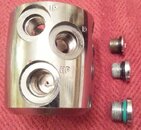
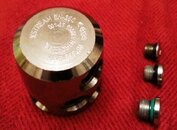
As you can see, the ports are standard US threads for both the HP and IP (LP) sides.
If you have an older Jetstream with the G1/8 threading, you'll need an adapter to thread it into the IP (LP) port.
The adapter that is pictured below is the
opposite of what you'd need. This one is for mating a standard US hose to an old G1/8 body.
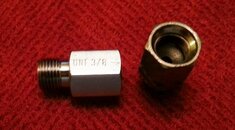
In your case, it's possible you'd need a G1/8 female to UNF 3/8 male, but I haven't seen one of those.
If they aren't easily found, the easier solution would be to get a standard Jetstream adapter and mate it to a US hose with a 3/8" thread.
They're available from Northeast Scuba Supply:
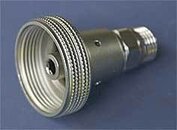
But then, you said you were contemplating an Odin octo (the American import of the Jetstream) with a 3/8" hose. It should fit right on!
For interest's sake, it's also worth noting Poseidon's convention when supplying US-threaded port plugs:
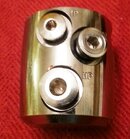
The top two plugs are both 3/8" US standard LP plugs. The top one is US-made and looks like any other plug. The middle one is supplied by Poseidon and has a ring around the face of the plug which indicates UNF thread. For Poseidon, a smooth plug indicates G1/8 thread. Be careful! I have a reg in the shop right now where a 3/8" hose was forced successfully into a G1/8 port. Unfortunately the body is now ruined, as the threads are cross-threaded from the wrong size.
Tuning your Jetstream/Odin for an IP of 135 is perfect. The factory spec for this regulator is 123-130 psi (8.5-9 bar), but it will tolerate higher IPs just fine. Tuning per the manual includes a step at 145 psi (10 bar) at 300 psi. This was due to the unbalanced old-style 1st stage which used to be supplied with the Jetstream, and which would show a higher IP as the tank emptied. So this factory specified two step process confirms that the Odin is designed to handle at least 123-145 psi IP. You will notice a slight abruptness to onset of flow with this design at shallow depths, which disappears down deep when the air is thicker.
Also note that the reg will freeflow if IP drops significantly below 100 psi, because there is not enough pressure to keep the bell valve snug up against the housing. That's why, if you follow standard American practice of
slowwwwlly opening your tank valve, the reg will freeflow. But this is normal, and the reg will seal as soon as you open the tank valve fully and the IP rises to normal levels.









